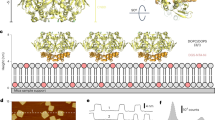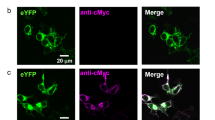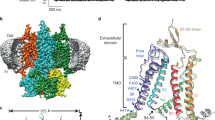Abstract
Cyclic nucleotide-gated (CNG) channels are crucial components of visual, olfactory and gustatory signalling pathways. They open in response to direct binding of intracellular cyclic nucleotides and thus contribute to cellular control of both the membrane potential and intracellular Ca2+ levels1. Cytosolic Ni2+ potentiates the rod channel (CNG1) response to cyclic nucleotides2,3,4 and inhibits the olfactory channel (CNG2) response5. Modulation is due to coordination of Ni2+ by channel-specific histidines in the C-linker, between the S6 transmembrane segment and the cyclic nucleotide-binding domain. Here we report, using a histidine scan of the initial C-linker of the CNG1 channel, stripes of sites producing Ni2+ potentiation or Ni2+ inhibition, separated by 50° on an α-helix. These results suggest a model for channel gating where rotation of the post-S6 region around the channel's central axis realigns the Ni2+-coordinating residues of multiple subunits. This rotation probably initiates movement of the S6 and pore opening.
This is a preview of subscription content, access via your institution
Access options
Subscribe to this journal
Receive 51 print issues and online access
$199.00 per year
only $3.90 per issue
Buy this article
- Purchase on Springer Link
- Instant access to full article PDF
Prices may be subject to local taxes which are calculated during checkout





Similar content being viewed by others
References
Yau, K. W. & Baylor, D. A. Cyclic GMP-activated conductance of retinal photoreceptor cells. Annu. Rev. Neurosci. 12, 289–327 (1989).
Gordon, S. E. & Zagotta, W. N. A histidine residue associated with the gate of the cyclic nucleotide-activated channels in rod photoreceptors. Neuron 14, 177–183 (1995).
Ildefonse, M., Crouzy, S. & Bennett, N. Gating of retinal rod cation channel by different nucleotides: comparative study of unitary currents. J. Membr. Biol. 130, 91–104 (1992).
Karpen, J. W., Brown, R. L., Stryer, L. & Baylor, D. A. Interactions between divalent cations and the gating machinery of cyclic GMP-activated channels in salamander retinal rods. J. Gen. Physiol. 101, 1–25 (1993).
Gordon, S. E. & Zagotta, W. N. Localization of regions affecting an allosteric transition in cyclic nucleotide-activated channels. Neuron 14, 857–864 (1995).
Cowan, J. A. Inorganic Biochemistry: An Introduction (Wiley-VCH, New York, 1997).
Sunderman, E. R. & Zagotta, W. N. Mechanism of allosteric modulation of rod cyclic nucleotide-gated channels. J. Gen. Physiol. 113, 601–620 (1999).
Maroney, M. J. Structure/function relationships in nickel metallobiochemistry. Curr. Opin. Chem. Biol. 3, 188–199 (1999).
Gordon, S. E. & Zagotta, W. N. Subunit interactions in coordination of Ni2+ in cyclic nucleotide-gated channels. Proc. Natl Acad. Sci. USA 92, 10222–10226 (1995).
Shammat, I. M. & Gordon, S. E. Stoichiometry and arrangement of subunits in rod cyclic nucleotide-gated channels. Neuron 23, 809–819 (1999).
Kneller, D. G., Cohen, F. E. & Langridge, R. Improvements in protein secondary structure prediction by an enhanced neural network. J. Mol. Biol. 214, 171–182 (1990).
Doyle, D. A. et al. The structure of the potassium channel: molecular basis of K+ conduction and selectivity. Science 280, 69–77 (1998).
Flynn, G. E. & Zagotta, W. N. Conformational changes in S6 coupled to opening of cyclic nucleotide-gated channels. Neuron 30, 689–698 (2001).
Ermler, U., Grabarse, W., Shima, S., Goubeaud, M. & Thauer, R. K. Active sites of transition-metal enzymes with a focus on nickel. Curr. Opin. Struct. Biol. 8, 749–758 (1998).
Brown, R. L., Snow, S. D. & Haley, T. L. Movement of gating machinery during the activation of rod cyclic nucleotide-gated channels. Biophys J. 75, 825–833 (1998).
Broillet, M. C. A single intracellular cysteine residue is responsible for the activation of the olfactory cyclic nucleotide-gated channel by NO. J. Biol. Chem. 275, 15135–15141 (2000).
Gordon, S. E., Oakley, J. C., Varnum, M. D. & Zagotta, W. N. Altered ligand specificity by protonation in the ligand binding domain of cyclic nucleotide-gated channels. Biochemistry 35, 3994–4001 (1996).
Zong, X., Zucker, H., Hofmann, F. & Biel, M. Three amino acids in the C-linker are major determinants of gating in cyclic nucleotide-gated channels. EMBO J. 17, 353–362 (1998).
Paoletti, P., Young, E. C. & Siegelbaum, S. A. C-linker of cyclic nucleotide-gated channels controls coupling of ligand binding to channel gating. J. Gen. Physiol. 113, 17–34 (1999).
Liu, D. T., Tibbs, G. R., Paoletti, P. & Siegelbaum, S. A. Constraining ligand-binding site stoichiometry suggests that a cyclic nucleotide-gated channel is composed of two functional dimers. Neuron 21, 235–248 (1998).
Perozo, E., Cortes, D. M. & Cuello, L. G. Structural rearrangements underlying K+-channel activation gating. Science 285, 73–78 (1999).
Perozo, E., Cortes, D. M. & Cuello, L. G. Three-dimensional architecture and gating mechanism of a K+ channel studied by EPR spectroscopy. Nature Struct. Biol. 5, 459–469 (1998).
Cortes, D. M., Cuello, L. G. & Perozo, E. Molecular architecture of full-length KcsA. role of cytoplasmic domains in ion permeation and activation gating. J. Gen. Physiol. 117, 165–180 (2001).
Matulef, K., Flynn, G. E. & Zagotta, W. N. Molecular rearrangements in the ligand-binding domain of cyclic nucleotide-gated channels. Neuron 24, 443–452 (1999).
Zagotta, W. N., Hoshi, T. & Aldrich, R. W. Gating of single Shaker potassium channels in Drosophila muscle and in Xenopus oocytes injected with Shaker mRNA. Proc. Natl Acad. Sci. USA 86, 7243–7247 (1989).
Hamill, O. P., Marty, A., Neher, E., Sakmann, B. & Sigworth, F. J. Improved patch-clamp techniques for high-resolution current recording from cells and cell-free membrane patches. Pflugers Arch. Eur. J. Physiol. 391, 85–100 (1981).
Acknowledgements
We would like to thank K. D. Black, G. Sheridan and especially H. Utsugi for technical assistance. We also thank A. D. Bragg, K. Craven, G. E. Flynn, K. Matulef, M. C. Trudeau and J. Zheng for their insightful discussions and critical reading of the manuscript.
Author information
Authors and Affiliations
Corresponding author
Rights and permissions
About this article
Cite this article
Johnson, J., Zagotta, W. Rotational movement during cyclic nucleotide-gated channel opening. Nature 412, 917–921 (2001). https://doi.org/10.1038/35091089
Received:
Accepted:
Issue Date:
DOI: https://doi.org/10.1038/35091089
This article is cited by
-
Two gates mediate NMDA receptor activity and are under subunit-specific regulation
Nature Communications (2023)
-
Functional and structural characterization of interactions between opposite subunits in HCN pacemaker channels
Communications Biology (2022)
-
CNG channel structure, function, and gating: a tale of conformational flexibility
Pflügers Archiv - European Journal of Physiology (2021)
-
An iris diaphragm mechanism to gate a cyclic nucleotide-gated ion channel
Nature Communications (2018)
-
Interaction of metal ions with neurotransmitter receptors and potential role in neurodiseases
BioMetals (2014)
Comments
By submitting a comment you agree to abide by our Terms and Community Guidelines. If you find something abusive or that does not comply with our terms or guidelines please flag it as inappropriate.



